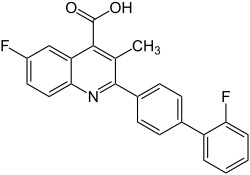Brequinar
Brequinar ist eine chemische Verbindung aus der Gruppe der Biphenylchinoline.
| Strukturformel | ||||||||||||||||
|---|---|---|---|---|---|---|---|---|---|---|---|---|---|---|---|---|
 | ||||||||||||||||
| Allgemeines | ||||||||||||||||
| Name | Brequinar | |||||||||||||||
| Andere Namen |
| |||||||||||||||
| Summenformel | C23H14F2NO2·Na · xH2O | |||||||||||||||
| Externe Identifikatoren/Datenbanken | ||||||||||||||||
| ||||||||||||||||
| Eigenschaften | ||||||||||||||||
| Molare Masse | 397,35 g·mol−1 | |||||||||||||||
| Sicherheitshinweise | ||||||||||||||||
| ||||||||||||||||
| Soweit möglich und gebräuchlich, werden SI-Einheiten verwendet. Wenn nicht anders vermerkt, gelten die angegebenen Daten bei Standardbedingungen. | ||||||||||||||||
Eigenschaften
Brequinar wurde in den 1980ern entwickelt und ist ein selektiver Hemmstoff der Dihydroorotat-Dehydrogenase im Mitochondrium und hemmt somit die Biosynthese von Pyrimidin-Nukleotiden und nachfolgende Biosynthesen wie die von Nukleinsäuren.[2] In Folge wird das Zellwachstum gehemmt. Daneben werden verstärkt Interferon-induzierbare Gene exprimiert.[3] Weitere Hemmstoffe der Dihydroorotat-Dehydrogenase sind Teriflunomid und Leflunomid.
Brequinar wurde als potenzielles Chemotherapeutikum sowie als Immunsuppressivum zur Vermeidung einer Abstoßungsreaktion nach Organtransplantation untersucht, erreichte aber aufgrund einer geringen Wirksamkeit,[2] therapeutischen Breite und bei Überdosierung schweren Nebenwirkungen nicht die Phase III.[4][2] Die hauptsächliche Nebenwirkung ist Myelosuppression,[2] mit einer Hemmung der Bildung von Interleukin-1 und Tumornekrosefaktor α sowie eine Hemmung der Aktivierung von T-Zellen.[5] Brequinar wurde bei manchen Krebsarten zur Verwendung in einer Kombinationstherapie untersucht,[6][7] sowie als Antiparasitikum[8] und Virostatikum.[9][10][11] In Zellkultur hemmt Brequinar die Virusreplikation von Denguevirus,[10] Westnilvirus,[10] Gelbfiebervirus,[10] Lassavirus,[10] Juninvirus,[10] Lymphozytäre-Choriomeningitis-Virus,[10] Vesicular stomatitis Indiana virus,[10] HIV-1,[10] Powassan-Virus[10] und Maul-und-Klauenseuche-Virus.[12]
Analytik
Die zuverlässige qualitative und quantitative Bestimmung von Brequinar gelingt nach angemessener Probenvorbereitung durch HPLC mit UV-Detektion bei 254 nm.[13]
Einzelnachweise
- Sigma-Aldrich: Brequinar sodium salt hydrate, ≥97% (HPLC)
- G. J. Peters: Re-evaluation of Brequinar sodium, a dihydroorotate dehydrogenase inhibitor. In: Nucleosides, nucleotides & nucleic acids. Band 37, Nummer 12, 2018, S. 666–678, doi:10.1080/15257770.2018.1508692 (freier Volltext), PMID 30663496.
- M. Lucas-Hourani, D. Dauzonne, P. Jorda, G. Cousin, A. Lupan, O. Helynck, G. Caignard, G. Janvier, G. André-Leroux, S. Khiar, N. Escriou, P. Desprès, Y. Jacob, H. Munier-Lehmann, F. Tangy, P. O. Vidalain: Inhibition of pyrimidine biosynthesis pathway suppresses viral growth through innate immunity. In: PLoS pathogens. Band 9, Nummer 10, 2013, S. e1003678, doi:10.1371/journal.ppat.1003678, PMID 24098125, PMC 3789760 (freier Volltext).
- D. V. Cramer: Brequinar sodium. In: Pediatric nephrology. Band 9 Suppl, 1995, S. S52–S55, doi:10.1007/bf00867685, PMID 7492488.
- X. Xu, J. W. Williams, J. Shen, H. Gong, D. P. Yin, L. Blinder, R. T. Elder, H. Sankary, A. Finnegan, A. S. Chong: In vitro and in vivo mechanisms of action of the antiproliferative and immunosuppressive agent, brequinar sodium. In: Journal of immunology. Band 160, Nummer 2, Januar 1998, S. 846–853, PMID 9551920.
- V. K. Vyas, M. Ghate: Recent developments in the medicinal chemistry and therapeutic potential of dihydroorotate dehydrogenase (DHODH) inhibitors. In: Mini reviews in medicinal chemistry. Band 11, Nummer 12, Oktober 2011, S. 1039–1055, doi:10.2174/138955711797247707, PMID 21861807.
- J. T. Madak, A. Bankhead, C. R. Cuthbertson, H. D. Showalter, N. Neamati: Revisiting the role of dihydroorotate dehydrogenase as a therapeutic target for cancer. In: Pharmacology & therapeutics. Band 195, 03 2019, S. 111–131, doi:10.1016/j.pharmthera.2018.10.012, PMID 30347213.
- D. Boschi, A. C. Pippione, S. Sainas, M. L. Lolli: Dihydroorotate dehydrogenase inhibitors in anti-infective drug research. In: European journal of medicinal chemistry. Band 183, Dezember 2019, S. 111681, doi:10.1016/j.ejmech.2019.111681, PMID 31557612.
- S. F. Li, M. J. Gong, Y. F. Sun, J. J. Shao, Y. G. Zhang, H. Y. Chang: Antiviral activity of brequinar against foot-and-mouth disease virus infection in vitro and in vivo. In: Biomedicine & pharmacotherapy = Biomedecine & pharmacotherapie. Band 116, August 2019, S. 108982, doi:10.1016/j.biopha.2019.108982, PMID 31146110.
- P. I. Andersen, K. Krpina, A. Ianevski, N. Shtaida, E. Jo, J. Yang, S. Koit, T. Tenson, V. Hukkanen, M. W. Anthonsen, M. Bjoras, M. Evander, M. P. Windisch, E. Zusinaite, D. E. Kainov: Novel Antiviral Activities of Obatoclax, Emetine, Niclosamide, Brequinar, and Homoharringtonine. In: Viruses. Band 11, Nummer 10, Oktober 2019, S. , doi:10.3390/v11100964, PMID 31635418, PMC 6832696 (freier Volltext).
- J. G. Park, G. Ávila-Pérez, A. Nogales, P. Blanco-Lobo, J. C. de la Torre, L. Martínez-Sobrido: Identification and Characterization of Novel Compounds with Broad-Spectrum Antiviral Activity against Influenza A and B Viruses. In: Journal of Virology. Band 94, Nummer 7, März 2020, S. , doi:10.1128/JVI.02149-19, PMID 31941776, PMC 7081893 (freier Volltext).
- S. F. Li, M. J. Gong, Y. F. Sun, J. J. Shao, Y. G. Zhang, H. Y. Chang: Antiviral activity of brequinar against foot-and-mouth disease virus infection in vitro and in vivo. In: Biomedicine & pharmacotherapy = Biomedecine & pharmacotherapie. Band 116, August 2019, S. 108982, doi:10.1016/j.biopha.2019.108982, PMID 31146110.
- Dasgupta S, Timby DM, Lam GN: Determination of brequinar in rat plasma by direct deproteinization and reversed-phase high-performance liquid chromatography with ultraviolet absorbance detection., J Chromatogr B Biomed Appl. 1995 Nov 3;673(1):107-12, PMID 8925063